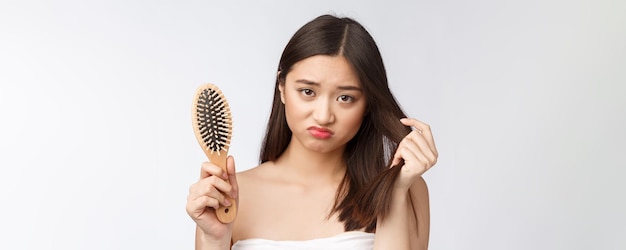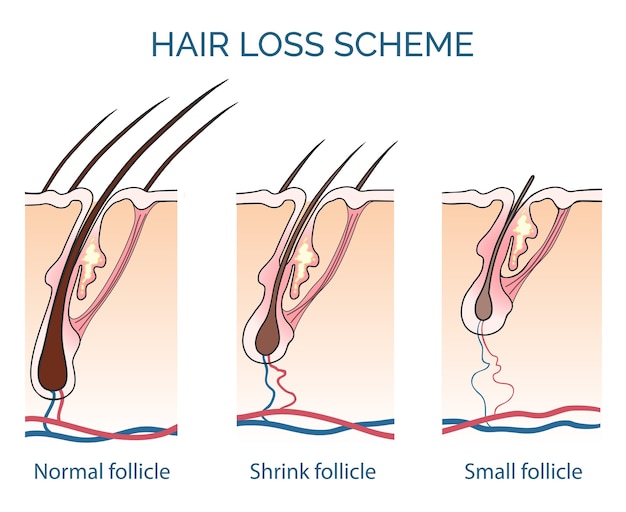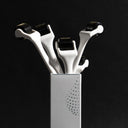There is more to hair damage than split ends. Extremely damaged hair's outer layer creates fissures. Once the cuticle has lifted, your hair is susceptible to additional damage and breaking. It may also appear dull or frizzy and be difficult to control. So, is it possible to transform dry, brittle hair into silky, lustrous locks?
The solution is not always clear-cut. Most hair damage is irreparable since hair is a collection of dead cells incapable of repair. Time, a pair of shears, and taking measures to prevent more damage are the only natural remedies. You can rebuild your hair's outer cuticle with good hair health and care and a few targeted treatments.
Table of content
What is damaged hair?

In the case of damaged hair and hair follicles, the cuticles of the outer coat are raised, exposing the inner cortical layer. The hair shaft is composed of three layers:
- Medulla - the innermost layer
- Cortex - the second layer that comprises melanin & keratin fibres
- Cuticle - the outermost layer formed of overlapping dead cells
Healthy hair of hair will have smooth, shiny cuticles that are flat to seal in moisture and prevent damage to the inner layers. Hair cuticles become damaged due to overuse of hair dye and chemical procedures, rough products and grooming procedures, exposure to UV radiation, and pollution.
The hair becomes brittle, damaged, and frizzy as a result, and it also breaks more easily. Before beginning hair and repair, you must determine the sort of hair damage you face.
As your leading source for hair health information over the past 4 years, we never compromise on accuracy. When it comes to your health, you deserve information you can truly rely on - and earning your trust is our top priority.
Here's how Scandinavian Biolabs ensures every piece of content meets the highest standards of accuracy and integrity:
- Credentialed Experts: Our reviewers are actively practicing doctors and medical researchers
- Stringent Reviews: Content undergoes rigorous editing by subject specialists and review by a practicing doctor.
- Evidence-Based: We rely on well-established research from trusted scientific sources like peer-reviewed journals and health authorities.
- Full Transparency: Our editorial standards, writer credentials, reviewer credentials, correction process, and funding are all publicly documented.
- Independent Voice: While we do promote products, we operate in a vacuum to business operations. Our main goal is just an unwavering commitment to providing medically-sound guidance.
You can count on Scandinavian Biolabs to consistently deliver the trustworthy health information you deserve. Read our Editorial Standards.
What are the types of hair damage?
The types of hair damage you might see are dry and dull hair, tangles, colour damage, breakage and brittleness, and frizzy hair.
Dry and dull hair
Damaged hair lacks natural oils on the outermost layer of the hair. This reduces the shine of the hair. Shampoos with harsh chemicals can deplete the scalp and hair's natural oils. Wash your hair less frequently and with gentle shampoos formulated specifically for your hair nourishment.
Tangles
Damaged hair is prone to tangling. The enlarged cuticles cause friction among the hair strands leading to tangles. A lack of moisture in the hair may aggravate this issue. Begin at the bottom and work your way up with a wide-toothed brush. Detangling conditioners, sprays, masks, and oils come to your rescue.
Frizzy hair
Frizz may occur if the cuticle doesn't lie down. Frizz can appear on the hair's surface, crown, top, or ends. Curly hair can be exacerbated by humidity and damaged hair. Serums aid in the control of frizz.
Colour damage
Even taking a break from regular foils will not undo years of lifting and colour loss; you must wait for the dye or bleach to fade before you can repair the damage. However, there is a good approach for ensuring that your colour causes the least damage: Find a specialist who is knowledgeable about the state of your hair.
Breakage and brittleness
A split end occurs when a hair strand splits into two. It can make hair brittle and prone to breakage. Split ends can be effectively repaired with good hair growth serums, hair dusting, and good hair recovery conditioners.
What triggers hair damage?

A variety of factors can cause hair breakage. Healthy hair's inner cuticle comprises overlapping scales that hold the strands together. Hair can become fragile and finally detach when these scales crack, causing damage. This causes breaking as well as additional symptoms such as frizz and dryness.
Uncut hairstyles
Trimming your hair may appear to cause damage. Hair trims can help you keep your hair healthy and free of broken ends. Hair exfoliation is comparable to skin exfoliation in both cases. You may need to remove some old cells to encourage the formation of new cells.
Split ends generate cracks in the cuticle, which can travel up the rest of your hair's length and cause breaking. Depending on the length and structure of your hair, you should see your hairdresser every eight weeks. Even if you're trying to grow out your hair, cutting split ends may avoid more damage.
Heat damage
For the best results with your hair dryer, flat iron, or curling iron, you should set it to a high temperature. But if you use these tools wrong or too much, you risk hurting your cuticles because of the high temperatures. Give your strands a break from all styling tools at least once weekly to avoid general heat damage.
Choose ceramic styling tools to protect your hair from heat damage. These heat up more evenly, so you don't have to use them over and over in the same spots. It is also critical to protect your hair before using heat. To reduce the damage, use a heat-protecting spray.
Bleaching
Bleaching lightens hair two tones lighter than the original colour. Melanin, the pigment that gives hair its colour, is dissolved throughout the procedure. Bleaching can make hair dry, brittle, and coarse. It can also make the hair less supple. Extreme bleach-damaged hair are hard to repair, but not impossible.
Use sun hair protection oils, such as hats and caps and hair-hydrating treatments to prevent further bleaching damage. Save your hair from chlorinated swimming pool water as well. It can turn your hair green and drain it of moisture
Diet
The phrase "you are what you eat" holds a lot of truth, especially regarding hair and skin health. Certain nutrients encourage hair development and prevent breakage caused by damage.
Ensure you get enough zinc, iron, and folic acid daily. Protein (amino acids for hair) and antioxidants (commonly plentiful in vegan or vegetarian diets) can also help prevent hair damage. Some vitamins like biotin and B12 may also help with hair growth.
Stress
Stress and hair loss have been linked in many studies, and stress can also cause hair to break. Telogen effluvium, a common form of stress-related alopecia, is most likely associated with hair damage. Stress causes follicles to go dormant. Hairs in the middle of their growth cycle may fall out. You may also notice that your old hair is falling out. Stress reduction may result in healthier hair.
Dryness
Damage and breakage can occur when hair is dehydrated. It can also be caused by dry weather, low humidity, and extreme heat. When washing your hair, use warm water rather than hot water, which may create more dryness.
If your hair ends are dry, consider concentrating shampoo on your scalp. It is also unacceptable not to use conditioner. Consider applying a hair mask to your hair's mid-lengths and ends. If you're pressed for time, spritz on a leave-in conditioner before brushing damp hair.
Stretchy hair ties

Elastic hair ties are essential for keeping hair out of the face while exercising. They are undeniably helpful on bad hair days or when you are in a hurry. Hair ties are problematic because they hurt the skin and hair cuticles.
You may even notice hair loss when you remove your ponytail. You can avoid this by wearing your hair down occasionally or adjusting your updo, so it doesn't pull on your hair. Also, ensure you're using real hair ties rather than rubber bands, which might damage your hair.
Hypothyroidism
Hypothyroidism (low thyroid illness) is characterized by the thyroid gland producing insufficient thyroid hormones. Despite its small size, the thyroid is essential to keeping your body working. This includes your metabolic rate, heart rate, and even hair growth.
Hypothyroidism can cause a lot of hair loss and damage, especially in the shower or after brushing. See your doctor for a thyroid exam if you have dry, damaged hair, low energy, sudden weight gain, and sorrow.
Eating disorders
Hair damage could be a sign that you or a loved one has an eating disorder. This is because eating disorders like anorexia and bulimia nervosa can lead to not getting enough food. When this happens, the hair follicles don't have the nutrients they need to make new hair, so the process stops.
You may even notice new hairs falling out during the growth cycle. Eating disorders can have serious consequences and demand medical attention. Reading the personal tales of others who have overcome eating disorders may inspire you or a loved one to get help.
How to repair damaged hair naturally?
To repair damaged hair naturally, follow these 17 effective methods:
- Try natural hair growth routine: Use products with plant growth factors for healthier hair growth.
- Utilize an improved shampoo and conditioner: Choose products with keratin, vitamins D3, E, and B5.
- Get regular trims: Trim hair every 4-6 weeks to remove split ends.
- Don't comb wet hair: Use a wide-tooth comb and leave-in conditioner on damp hair.
- Limit chlorine exposure: Protect hair from chlorine in pools with anti-chlorine products.
- Include an oil: Use argan or coconut oil for softening and taming hair.
- Look for bond-repair treatments for hair: Employ bond-building treatments for stronger hair structure.
- Don't shampoo daily: Use dry shampoo to maintain natural scalp oils.
- Loosen your style: Avoid tight hairstyles to prevent breakage.
- Reduce hot appliance temperature: Use lower heat settings on styling tools.
- Apply leave-in conditioner: Use leave-in treatments for extra moisture and protection.
- Start examining your scalp: Maintain a healthy scalp for stronger hair growth.
- Enjoy rejuvenating hair masks: Apply hair masks regularly for deep conditioning.
- Embrace leave-ins: Use leave-in conditioners for continuous protection.
- Obtain expert treatments: Seek salon treatments for severe hair damage.
- Seal your bonds: Use bond-protecting products during hair coloring.
- Start taking vitamins: Supplement with vitamins for overall hair health.
1. Try natural hair growth routine

The Hair Growth Routine was created to help prevent hair loss, grow new strands, and maintain healthy, strong hair. Each product contains plant growth factors made with stem cell technology to feed hair follicles and help them grow back.
The technique by which this compound increases healthy hair growth is straightforward. Capilia Longa - the main active ingredient - is meant to stimulate the activity of dermal papilla cells to control the hair growth cycle.
Even though we can't change things like our genes, clinical studies have shown that after 150 days of using the Hair Growth Routine, the anagen (growth) phase of the hair-growing cycle gets better and the telogen (rest) phase gets worse. The formula aims to provide people with naturally fuller hair that takes longer to grow. All without any side effects.
With the help of a scientists to "close the gap," the Hair Growth Routine was developed by Scandinavian Biolabs, a natural solution with low side effects that passed clinical testing, confirming its efficacy in combating hair loss.
2. Utilize an improved shampoo and conditioner
To keep your hair from getting damaged, there are a few key things you should look for in your shampoo and conditioner. Keratin is a moisturizer made up of molecules similar to the keratin found in hair's genetic makeup.
The tiny particles can penetrate the hair, making it feel softer, fuller, and shine brighter. Additionally, look for vitamins D3, E, and B5, which have a variety of functions but all contribute to hair and scalp health.
3. Get regular trims
Even if you've been growing out your hair for what seems like an eternity, it's essential to have regular trims to remove split and dry ends. You most likely cut your nails and exfoliate your skin. It's the same idea.
When you cut off these broken ends, they can't move up the hair shaft and cause more length loss. Tengler recommends getting a haircut every four to six weeks if you want to keep your current cut and every six to eight weeks if you're going to grow it out.
4. Don't comb wet hair
Brushing damp hair is permitted if used to detangle wet, fragile hair. When in doubt, choose a comb with wide teeth that will not snag hair when it is weakest. Use a leave-in conditioner when brushing wet hair to keep it from breaking and getting caught.
5. Limit chlorine exposure
Reduce the amount of time [your hair] spends in the water if at all possible. Chlorine in pools strips hair of its natural oils, leaving it dry, harsh, and damaged. Use anti-chlorine products if you swim or spend much time with your hair in the water. And don't forget about the hair masks!
6. Include an oil
Tengler softens and tames her hair by using argan oil, which has fatty acids and vitamin E, and regular coconut oil.
Apply a tiny amount of argan oil to soften strands when your hair is feeling particularly harsh, such as after a swim in the pool; you can also make a leave-in conditioner with coconut oil. After heating your hair, apply a little quantity from the mid-shaft to the ends.
Other oils you can use are: peppermint oil, lavender oil, pumpkin seed oil, and stinging nettle oil. Or, if you want maximum effectiveness, try one of the best hair growth oil from our list.
7. Look for bond-repair treatments for hair
Bond-building treatments are popular among expert hairstylists and colourists because they work on a molecular level to rebuild the broken links that give hair strength and structure. When were these bonds formed? Your hair will appear shinier, smoother, softer, and more vibrant.
8. Don't shampoo daily
It's time to become acquainted with dry shampoo. You and your stylist are aware of how frequently your scalp becomes oily. Few people wash their clothes every other day, while others wash them once a week. Avoid washing it every day if possible. Washing hair everyday can cause hair loss.
Reduce your washing frequency by one day per week if you already wash once daily. If you wash your hair too often, the natural oils on your scalp may be washed away before they have a chance to nourish the whole length of the hair shaft.
9. Loosen your style
Assume you see many split ends and breaks while styling your hair. Avoid tight hairstyles like ponytails and buns, especially if you're sleeping or your hair is still wet. The elastic breaks when you style your hair in a bun or ponytail while it is still wet and brittle. This also applies to buns and braids that have been neglected.
10. Reduce hot appliance temperature
If your hair has been coloured, you shouldn't use curling irons, flat irons, or blow dryers. If you have to use hot tools, do not heat them to their maximum temperature. Most heated tools have a minimum of three heat settings.
Consider these temperatures in terms of hair type: one for thin hair, another for medium hair, and the third for thick hair. Use the low or medium heat setting if you have fine, colour-treated hair. Don't forget about the heat protectant, which can help avoid further damage when using an iron or blow dryer.
11. Apply leave-in conditioner
Even if you condition your hair or use a mask, you still need leave-in treatments to fix dry, curly hair and keep it from getting worse. Leave-in conditioners smooth, soften, and detangle curly, straight, or wavy hair.
12. Start examining your scalp
Plants that are strong and vigorous will not thrive in poor soil. The same is true for your hair. If your scalp is nourished and healthy, the hair that grows from it will be as well. Scalp care is critical if you've stopped shampooing and increased dry hair use. The scalp can get irritated and inflamed when dirt and other debris from daily life build up on it. Try a weekly scrape to get rid of all the buildup and adequately clean the area.
Better yet, use a scalp massager to aerate your scalp, improve blood flow and remove any buildup.
13. Enjoy rejuvenating hair masks
Hair masks are conditioning agents. They contain vitamins, oils, and natural elements that are incredibly reparative and moisturizing. They are also thicker than traditional conditioners, which allows them to stay in place when applied to wet hair. This enables the solutions to go deeper into the hair surface and cure the gaps and nicks caused by the damaged hair surface.
Masks continue to operate even after you rinse them. Choose a mask appropriate for your hair type, such as colour-treated, harsh, or unruly. At least twice a week, apply your hair treatment mask. Furthermore, the longer you keep it on, the more effective it becomes.
14. Embrace leave-ins
Leave-in conditioners and hair treatments act as 24-hour bodyguards for your hair. Because they are not eliminated, they continue to serve and defend from shampoo to shampoo. Like other hair treatments, leave-in conditioners can be tailored to your specific hair type. For example, leave-in conditioners for hair with a lot of colours will protect against UV light to keep the colour from fading.
Leave-in hair will add moisture to your unmanageable and frizzy hair, making it smoother and more manageable. Apply leave-in conditioners to damp, but not soaked, hair and spread evenly with a wide-tooth comb for best results.
15. Obtain expert treatments
For severely damaged hair, a do-it-yourself routine may be insufficient. When this happens, it may be necessary to call in experts. Professional salon hair treatments make use of the most potent active ingredients available.
They treat many sorts of hair damage, from over-processed or brittle strands to hair in desperate need of hydration. Your stylist often applies a hair damage treatment at the shampoo bowl, and because these treatments are so concentrated, you'll notice and feel a difference immediately!
16. Seal your bonds
Hair damage is caused by the chemical treatments used in hair dyeing and lightening. Hair colour or lighteners must break down the structural linkages of the hair to be effective. When hair connections are broken, the hair is more vulnerable to breakage, dryness, and damage. Putting chemicals in your hair colour and lightener that protect bonds can stop them from breaking down.
Furthermore, these formulations include preventative measures to avoid additional damage. Clients whose hair colour changes often and drastically call professional bonders "game changers" for hair health.
17. Start taking vitamins
Use a vitamin to support hair and scalp health that contains a comprehensive blend of nutrients to help grow, strengthen, and protect the hair. There are a wide variety of supplements you can take that include all the necessary nutrients for hair to grow.
How quickly can damaged hair be repaired?
Repairing damaged hair depends on the extent of the damage. For severe damage, it may take six to twelve months to see significant improvement, as you might need to wait for new, healthy hair to grow. Using products that nourish the scalp and hair can expedite this process, but patience and consistent care are key to restoring hair's natural health.
Will my damaged hair regrow healthily?
The only way to achieve perfectly healthy hair is to let it grow without further harming it. It will grow back healthy if you damage your hair by over-styling, over-heating, or over-colouring with harsh chemicals.
Isn't this normally the situation when you have a medical issue? Massaging your scalp might help promote hair growth. This is a great way to get healthy hair, even if your hair is damaged.
Will my hair come back once it has been broken?
Yes, damaged hair can grow back if the follicle is intact. Hair grows from the root, so avoiding strain on the root and maintaining good hair care practices is important. Ensuring a healthy diet and reducing stress can also aid in hair regrowth. Consider professional assistance or use lower heat settings for future hair treatments to minimize damage.
Read more:










